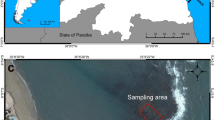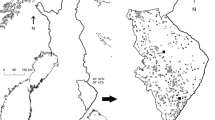Abstract
The intensity of interspecific territorial defense should be based upon the degree of competitive overlap. We tested this relationship in two territorial Caribbean damselfish (dusky, Stegastes adustus, and longfin, S. diencaeous) with intruders being the bluehead wrasse (Thalassoma bifascatus) and the slippery dick wrasse (Halichoeres bivittatus). Based on food habits, the slippery dick and the bluehead wrasse should have the same degree of competitive overlap to the two damselfish species. We also predicted that the larger slippery dick wrasse intruder would receive more aggression than the smaller bluehead wrasse intruder. Neither damselfish species distinguished between the two wrasses suggesting that they were ecologically equivalent. We also tested size differences within both species of wrasse and found that size had no influence on the aggression in the dusky damselfish. The longfin also did not show a size preference for the bluehead but did prefer to attack the larger slippery dick wrasse. In spite of the similarities between the dusky and the longfin damselfish and the similar food habits of the bluehead and the slippery dick wrasse, our results suggest that using intensity of interspecific territorial defense alone may not be an adequate measure of competitive overlap.



Similar content being viewed by others
References
Böhlke JE, Chaplin CCG (1968) Fishes of the Bahamas and adjacent tropical waters. Livingston, Wynnewood
Cheney KL, Côté IM (2003) Habitat choice in adult longfin damselfish: territory characteristics and relocation times. J Exp Mar Biol Ecol 287:1–12
Ebersole JP (1977) The adaptive significance of interspecific territoriality in the reef fish Eupomacentrus leucostictus. Ecology 58:914–920
Hixon MA, Brostoff WN (1983) Damselfish as keystone species in reverse: intermediate disturbance and diversity of reef algae. Science 220:511–513
Itzkowitz M (1980) Group formation of reef fishes induced through food provisioning. Biotropica 12:277–281
Itzkowitz M (1990) Heterospecific intruders, territorial defense, and reproductive success in the beaugregory damselfish. J Exp Mar Biol Ecol 140:49–59
Itzkowitz M (1991) Habitat quality and reproductive success in the beaugregory damselfish. Environ Biol Fish 30:287–293
Little K, Draud M, Itzkowitz M (2013) Interspecific aggression in two highly similar Stegastes damselfish. Ethol Ecol Evol 25:227–242
Mahoney BM (1981) An examination of interspecific territoriality in the dusky damselfish, Eupomacentrus dorsopunicans Poey. Bull Mar Sci 31:141–146
Moore FR (1978) Interspecific aggression: toward whom should a mockingbird be aggressive? Behav Ecol Sociobiol 3:173–176
Mullen SP, Little K, Draud M, Brozek J, Itzkowitz M (2012) Hybridization among Caribbean damselfish species correlates with habitat degradation. J Exp Mar Biol Ecol 416–417:221–229
Myrberg AA, Thresher RE (1974) Interspecific aggression: its relevance to the concept of territoriality in reef fishes. Am Zool 14:81–96
Ord TJ, Stamps JA (2009) Species identity cues in animal communication. Am Nat 174:585–593
Orians GH, Willson MF (1964) Interspecific territories of birds. Ecology 45:736–745
Peiman KS, Robinson BW (2010) Ecology and evolution of resource-related heterospecific aggression. Q Rev Biol 85:133–158
Randall JE (1967) Food habits of reef fishes of the West Indies. Stud Trop Oceanogr 5:665–847
Roberston RE (1995) Competitive ability and the potential for lotteries among territorial reef fishes. Oecologia 103:180–190
Stamps JA (1977) The relationship between resource competition, risk, and aggression in a tropical territorial lizard. Ecology 58:349–358
Turgeon K, Robillard A, Grégoire J, Duclos V, Kramer D (2010) Functional connectivity from a reef fish perspective: behavioral tactics for moving in a fragmented landscape. Ecology 91(11):3332–3342
Williams AH (1980) The threespot damselfish: a noncarnivorous keystone species. Am Nat 116:138–142
Author information
Authors and Affiliations
Corresponding author
About this article
Cite this article
Black, A., Imhoff, V., Leese, J. et al. Attack intensity by two species of territorial damselfish (Pomacentridae) as estimates of competitive overlap with two species of wrasse (Labridae). J Ethol 32, 63–68 (2014). https://doi.org/10.1007/s10164-013-0393-x
Received:
Accepted:
Published:
Issue Date:
DOI: https://doi.org/10.1007/s10164-013-0393-x




